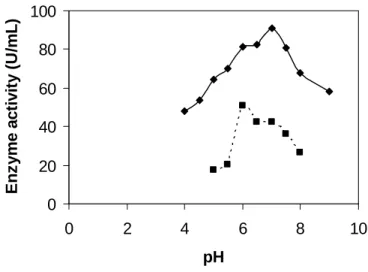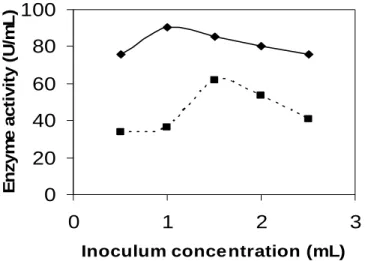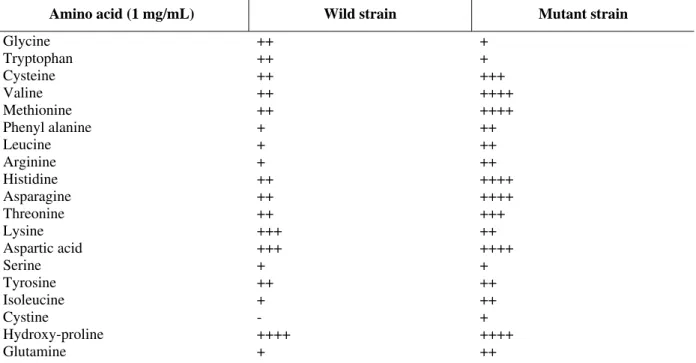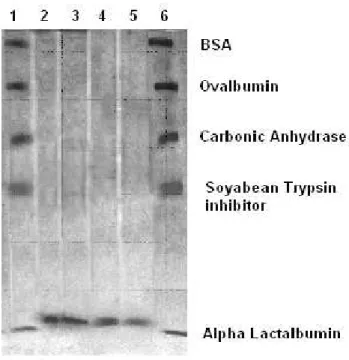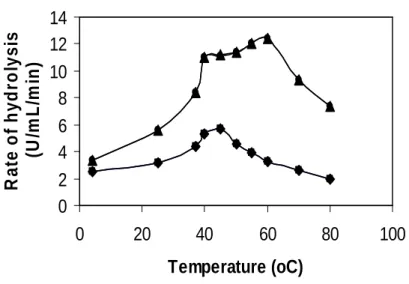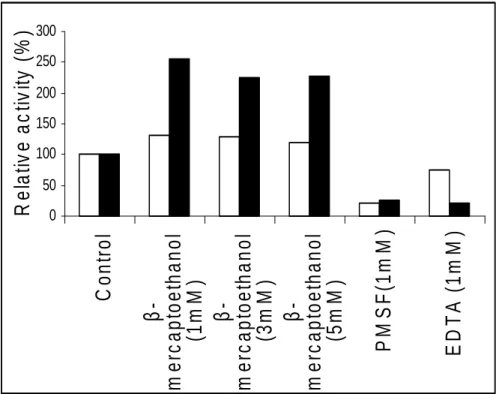Vol. 49, n. 1 : pp. 37-47, January 2006
ISSN 1516-8913 Printed in Brazil BRAZILIAN ARCHIVES OF
BIOLOGY AND TECHNOLOGY A N I N T E R N A T I O N A L J O U R N A L
Isolation and Characterization of a Newly Isolated
Pseudomonas Mutant for Protease Production
Jayati Ray Dutta and Rintu Banerjee∗
Microbial Biotechnology and Downstream Processing Laboratory; Agricultural and Food Engineering Department; IIT; Kharagpur - 721302; India
ABSTRACT
A potent bacterium for extracellular protease production was isolated from local soil and identified as Pseudomonas sp. RAJR 044. A mutant of this strain JNGR 242 with protease productivity 2.5 fold higher was obtained by ultraviolet irradiation under experimentally optimized conditions of pH 7.0, temperature of 34OC, inoculum volume of 1.0 mL and incubation time of 24 hours. Comparative analysis of the chemical characteristics i.e. assimilation of carbon and nitrogen sources were also carried out. Maximum growth of the mutant strain in 2% gelatin agar plate was obtained in presence of dextrose (2%), maltose (2%), ammonium sulfate (2%) and potassium nitrate (2%) whereas, that of the parent strain was found in sucrose (2%) and ammonium nitrate (2%). The purified proteases from both the strains (parent and mutant) appeared as single homogeneous bands corresponding to 14.4 kDa molecular weight on SDS-PAGE. On studying the kinetic properties of both strains it was observed that the rate of casein hydrolysis was maximum at pH 8.0 and 7.0 and temperatures 45O C and 60O C for the parent and mutant strains respectively. It was also observed that both the extracellular proteases were inhibited by a serine protease inhibitor i.e. PMSF at 2mM concentration.
Key words: Extracellular protease, Purification, Kinetic characterization, Ultraviolet mutagenesis, Pseudomonas sp., Physicochemical
∗ Author for correspondence
INTRODUCTION
Protease is one of the most important industrial enzymes occupying nearly 60% of the enzyme sales, obtained from microbial, plant and animal sources (Godfrey and Reichelt, 1983). Extracellular protease finds numerous applications in industrial processes like in detergents, leather tanning, dairy, meat tenderization, baking, brewery, photographic industry etc. (Moses and Cape, 1991).
The success of microbial proteases in food and other biotechnological systems could be attributed to the broad biochemical diversity of the
microorganisms, to the genetic manipulation of the organisms and the improvement of the techniques in the enzyme production, purification and characterization. Information pertaining to the rates of activation and inactivation of enzymes and their functional efficiency constitutes the kinetic data, which determines the way in which the reaction occurs. Reaction rates are often heavily influenced principally by conditions such as substrate, activator, inhibitor, enzyme concentration, pH, redox potential, temperature, etc.
Takami et al., 1990; Mabrouk et al., 1999) as well as on mutation of Pseudomonas sp. for lipase production (Xiu-Gong Gao et al., 2000; Jaeger et al., 1999) and polysaccharide production (West, 2002) have been reported. However, reports on ultraviolet (UV) mutation of Pseudomonas sp. for protease production are very few. A search for UV irradiated improved bacterial strain for protease production led to the isolation of a novel mutant strain JNGR 242 of Pseudomonas sp. RAJR 044 with enhanced protease production. We report here the isolation, purification, physicochemical and enzyme characterization of the extracellular protease from both the novel mutant strain JNGR 242 and parent strain of Pseudomonas sp.
RAJR 044.
MATERIALS AND METHODS
Microorganism
A new soil isolate from Indian Institute of Technology (IIT) Kharagpur, identified as
Pseudomonas sp. RAJR 044 was used, which was maintained on 2% nutrient agar slants at 4oC.
Chemicals
All chemicals were of analytical grade. Wheat bran was purchased from the local market.
Composition of media
Nutrient agar (2%), Czapek-dox media composition: NaNO3 2.5 g/L; KH2PO4 1.0 g/L; MgSO4.7H2O 0.5 g/L;KCl 0.5 g/L, Gelatin agar (2%)
Inoculum preparation
For inoculum preparation, 10 mL of sterile distilled water was added to the slant grown on nutrient agar plate for 3 days at 30OC and cells were scraped with inoculating loop in a Laminar Air Hood, (Klenzaids, India). This suspension (3x107cells/mL) was used as inoculum for subsequent fermentation.
Mutagenesis by ultraviolet irradiation (Saha and Battacharyya, 1990 a)
Seven test tubes with the aforesaid bacterial suspension were taken and one of them (the control) was kept aside in dark and the rest six were given UV radiation (2600 AO) for time periods varying from 5 minutes to 30 minutes with samples being collected at 5 minutes interval.
After UV radiation they were kept in dark for stabilization of thymine-thymine (T-T) dimers. A 0.1mL of the UV treated bacterial suspensions was then inoculated in 25mL Petri plates containing 1% gelatin and 2% agar. These were incubated for 48 hour at 35oC for colony formation. After the formation of colonies, the plates were flooded with HgCl2-HCl solution for 5 minutes and the transparent circular zones around the colonies in an opaque white background detected protease secretion. Mutants for hyper-production of protease were detected visually by the intensity of the zones. A clearer zone, i.e., a more intense zone, meant more protease secretion. The mutants were grown for 13 generations and protease production was tested in each generation. Those that showed better protease production than the parent strain after 13 generations were selected as stable mutants.
Fermentation
To examine the variations of the isolated novel mutant from the parent strain, their morphology, environmental parameters influencing protease secretion under submerged fermentation and chemical parameters affecting their growth were studied. The optimum conditions for protease production by both strains with respect to incubation period, temperature, pH and inoculum volume were obtained by conducting the experiments in 250mL Erlenmeyer flask containing the sterilized wheat bran and Czapek-dox medium in 1:10 ratio, inoculated with the bacterial suspension for 3 days at 30O C. After fermentation, the enzyme was extracted and centrifuged at 10,000 rpm for 10 minutes at 4oC to remove insoluble materials. The supernatant was stored at 4oC and used as the enzyme source for the assay of protease activity. The study of the chemical parameters was done by observing the growth of both strains in 2% gelatin agar plates in presence of different sources of carbon, nitrogen, amino acids and antibiotics. The experiments were conducted in duplicate and the results were the average of these two independent trials.
Assay of protease
(min-1) under the assay conditions (Patil and Shastri, 1981).
Protease purification
The fermented broth was centrifuged at 10,000rpm for 10 minutes to separate the insoluble followed by acetone precipitation in the ratio of 1:2 at 4oC for 3 hour. After acetone precipitation, the enzyme samples were dissolved in minimum buffer solution and further purified by carboxy-methyl (CM)-Sephadex column chromatography. The final purity of the enzyme was judged by sodium dodecyl sulfate-polyacrylamide gel electrophoresis (SDS-PAGE) according to Laemmli (Laemmli, 1970). The final purified supernatant was used for the comparative study of protease kinetics on casein hydrolysis of the parent and mutant strains.
Kinetic properties of protease:
effect of pH and temperature on casein hydrolysis
To evaluate casein hydrolysis at different pH (ranging from 3-11), 0.02mL of enzyme samples from both parent and mutant strains were added to 2 mL of casein from 2% stock solution. For pH 3-6, glycine-HCl buffer was selected whereas for pH 8-11, 0.2M glycine-NaOH buffer was selected. Phosphate buffer of similar ionic strength was used for 7.0. The reaction mixtures were incubated for 15 minutes at 37OC.
Similarly, to study casein hydrolysis at different temperatures experiments were designed at pH 8.0 for parent strain and that for mutant strain at 7.0 with the reaction being carried out at different temperatures ranging from 4OC-80OC for 15 minutes. Thereafter, the enzyme activities were determined.
Effect of inhibitors on protease activity
To study the effect of inhibitors on protease activity, 0.02mL of enzyme samples were incubated at optimum pH and temperatures along with varying concentrations of β-mercaptoethanol (cysteine protease inhibitor), EDTA (metallo protease inhibitor) and PMSF (serine protease inhibitor) for 15 minutes and then protease activity was determined.
RESULTS AND DISCUSSION
Strain improvement by mutation
The mutation and screening of industrially useful microorganisms are important for the successful development of the various strains required in the fermentation industry. The productivity of the parent strain RAJR 044 under investigation was improved by UV mutation. The survival data obtained on UV treatment for varying time periods are presented in Table 1.
Table 1 - Survival data for Pseudomonas sp. on UV treatment.
Duration of UV light (minutes) Number of colony Germinated Survival percentage (%)
0 4500 100
5 22 0.49
10 18 0.40
15 13 0.29
20 8 0.18
25 2 0.04
30 1 0.02
Survival (%) was calculated as follows:
For a treatment time (t) Survival (%) =100x (Colony count obtained for time (t))/4500
UV treatment for 10 minutes resulted in a strain designated as JNGR 242. It was observed that morphologically both parent and mutant strains looked alike and showed whitish slimy growth. On studying the enzyme production on wheat bran with Czapek-dox in the ratio of 1:10, it was found that the mutant was hyper active giving approximately about 2.5 fold increase in protease production over the parent strain (i.e. parent strain
gave 40.01U/mL whereas mutant gave 99.78U/mL).
Environmental parameters affecting protease production
strain (Fig. 1). However, the increase in activity dropped drastically after three days, which could be attributed to exhaustion of nutrients.
Fig. 2 showed that protease production was maximum at pH 6.0 for the parent and at pH 7.0 for the mutant strain. As the metabolic activities of
the microorganisms were very sensitive to pH change, protease production was affected, if pH level was higher or lower compared to the optimum value (Tunga et al., 1998; Ali and Roushdy, 1998).
0 20 40 60 80 100
0 50 100 150
Incubation time (h)
E
n
z
y
m
e
a
c
ti
v
it
y
(
U
/m
L
)
Figure 1 - Effect of incubation period on protease production. (…■…) for parent, (—♦—) for mutant.
0 20 40 60 80 100
0 2 4 6 8 10
pH
E
n
z
y
m
e
a
c
ti
v
it
y
(
U
/m
L
)
Figure 2 - Effect of initial pH on protease production. (…■…) for parent, (—♦—) for mutant.
Fig. 3 showed that 30oC for the parent strain and 34oC for the mutant strain was the optimum temperature for maximum secretion of extracellular protease. Higher temperature was found to have adverse effect on the metabolic activities of the microorganism, which became
slow at lower temperature (Tunga et al., 1998; Singh and Vyas, 1975).
strain as shown in Fig. 4. This indicated that the inoculum concentration had some optimum value depending on the microbial species and fermentation system (Tunga et al., 1998).
Chemical parameters affecting the growth of parent and mutant strains
The results on the study of assimilation of carbon sources (Saha and Bhattacharyya, 1990 b; Mabrouk et al., 1999) in Table 2 showed that maximum growth was in sucrose for the parent strain whereas, for the mutant strain in presence of dextrose and maltose (a disaccharide of glucose). The results on the study of nitrogen sources in Table 3 showed that the parent strain grew best in presence of ammonium nitrate, whereas the mutant strain in ammonium sulfate and potassium nitrate
(Saha and Bhattacharyya, 1990 b; Mabrouk et al., 1999). But both the strains could not assimilate urea (Law, 1980).
The results of the uptake of amino acids by the parent and mutant strains (Table 4) showed that the mutant was able to maximally utilize amino acids like hydroxyl-proline, aspartic acid, asparagines, histidine, valine, methionine, whereas the parent strain showed maximum growth only in presence of hydroxyl-proline and was unable to utilize cystine.
The results of the response to antibiotics by both strains (Table 5) showed that both were resistant to all concentrations of ampicillin and penicillin but no growth at all in tetracycline proving their sensitivity to this particular drug (Kvasnikov et al., 1975).
0 20 40 60 80 100
0 10 20 30 40 50 60
Temperature (oC)
E
n
z
y
m
e
a
c
ti
v
it
y
(
U
/m
L
)
Figure 3 - Effect of temperature on protease production. (…■…) for parent, (—♦—) for mutant.
Table 2 - Assimilation of various carbon sources by mutant and parent strains.
Carbon sources (2%) Parent strain Mutant strain
Lactose Sucrose Galactose Fructose Dextrose Maltose Mannitol
+ +++++ + ++++ ++ ++ +
+ ++ +++ +++ +++++ +++++ +
0
20
40
60
80
100
0
1
2
3
Inoculum conce ntration (mL)
E
n
z
y
m
e
a
c
ti
v
it
y
(
U
/m
L
)
Figure 4 - Effect of inoculum concentration on protease production. (…■…) for parent, (—♦—) for mutant.
Table 3 - Assimilation of various nitrogen sources by mutant and parent strains. Nitrogen
sources (2%)
Parent strain Mutant strain
Sodium Nitrite Ammonium Nitrate Urea
Potassium Nitrate Ammonium Sulphate Sulphate
Ammonium chloride Liver extract
+ +++++ - ++ +++ + +++
+ ++ - +++++ +++++ ++ +++
Enzyme purification
Protease recovery by acetone precipitation was 45.6% with 4.0 fold purification for the parent and 50.2% with 4.5 fold for the mutant strain (Tables 6 and 7). Then the final purity and molecular weight of the enzymes from both parent and mutant strains was observed by carboxy-methyl (CM)-Sephadex ion exchange chromatography and SDS-PAGE. It was observed that the purified proteases from both strains migrated as a single band of 14.4 kDa in SDS-PAGE (Fig. 5) suggesting that the purified proteins were homogeneous. Similarly from the literature review another extracellular protease from pseudomonas fluorescens 22F was
Table 4 - Utilization of various amino acids by mutant and wild strains.
Amino acid (1 mg/mL) Wild strain Mutant strain
Glycine Tryptophan Cysteine Valine Methionine Phenyl alanine Leucine Arginine Histidine Asparagine Threonine Lysine Aspartic acid Serine Tyrosine Isoleucine Cystine
Hydroxy-proline Glutamine
++ ++ ++ ++ ++ + + + ++ ++ ++ +++ +++ + ++ + - ++++ +
+ + +++ ++++ ++++ ++ ++ ++ ++++ ++++ +++ ++ ++++ + ++ ++ + ++++ ++
Symbols: ++++ strong positive growth; +++ positive growth; ++ weak positive growth; + Very weak positive growth; - no growth.
Table 5 - Response to various antibiotics by mutant and parent strains.
Antibiotics (µg/mL) Wild strain Mutant strain
Ampicillin : 50 100 200 Penicillin: 50 100 200 Tetracycline: 50 100 200
Uniform colonies Few colonies Less colonies Very dense growth Less colonies Less colonies No growth at all No growth at all No growth at all
Uniform colonies Many colonies Less colonies Very dense growth Less colonies Less colonies No growth at all No growth at all No growth at all
Table 6 - Protease purification by various methods for parent strain.
Purification steps Volume
(mL)
Total activity
(units)
Total protein
(mg)
Specific activity (U/mg)
Protease recovery
(%)
Fold purification
Crude extract 50 2000 525 3.81 100 1.0
Acetone treatment 3.0 912 59.9 15.23 45.6 4.0
Table 7 - Protease purification by various methods for mutant strain.
Purification steps Volume
(mL)
Total activity
(units)
Total protein
(mg)
Specific activity (U/mg)
Protease recovery
(%)
Fold purification
Crude extract 50 5000 925 5.4 100 1.0
Acetone treatment 3.5 2510 103.1 24.4 50.2 4.5
CM-Sephadex 15.5 1030 35.3 29.2 20.6 5.4
Kinetic properties ofprotease
The pH affects the ionization of amino acids, which dictate the primary and secondary structure of enzyme and hence control its activity. A typical bell-shaped curve was obtained for both the parent and mutant strains with the optimum values at pH 8.0 and pH 7.0, respectively (Fig. 6). A fall in the hydrolysis rate on either side of the optimum values was due to decrease in affinity of enzyme for the substrate (Godfrey and Reichelt, 1983). The temperature also influences enzyme reaction rate. The ideal assay temperature found in this
study was 45oC for the parent and 60oC for mutant strain (Fig. 7). The advantage of higher temperature was that reaction rates would be high enough to ensure completion within a few minutes, and the risk of denaturation was minimal (Godfrey and Reichelt, 1983). Increase in temperature above optimum affects important factors as protein denaturation, protein ionization state and solubility of species in solution (Zeffren and Hall, 1973) reducing enzyme activity.
0
2
4
6
8
10
12
0
5
10
15
pH
R
a
te
o
f
h
y
d
ro
ly
s
is
(U
/m
L
/m
in
)
Figure 6 - Effect of pH on casein hydrolysis. ● = parent, ▲= mutant.
0
2
4
6
8
10
12
14
0
20
40
60
80
100
Temperature (oC)
R
a
te
o
f
h
y
d
ro
ly
s
is
(U
/m
L
/m
in
)
Figure 7 - Effect of temperature on casein hydrolysis. ● = parent, ▲= mutant.
Fig. 8 shows the nature of protease activity for both parent and mutant strains in presence of different protease inhibitors. The cysteine protease inhibtor i.e β-mercaptoethanol at 1mM concentration acted as an inducer of protease activity promoting 30% activity in the parent and 150% in mutant strain whereas EDTA inhibited
0 50 100 150 200 250 300
C
o
n
tr
o
l
β
-m
e
rc
a
p
to
e
th
a
n
o
l
(1
m
M
)
β
-m
e
rc
a
p
to
e
th
a
n
o
l
(3
m
M
)
β
-m
e
rc
a
p
to
e
th
a
n
o
l
(5
m
M
)
P
M
S
F
(1
m
M
)
E
D
T
A
(
1
m
M
)
R
e
la
ti
v
e
a
c
ti
v
it
y
(
%
)
Figure 8 - Effect of inhibitors on protease activity. □ = parent, ■ = mutant.
CONCLUSION
Thus, from the above results it could be concluded that the UV irradiated mutant JNGR 242 showed a significant i.e. 2.5 fold increase in productivity over the parent strain and that this radiation had no special effects on the morphology of the strains but some effects on the biochemical characteristics of the organism which further suggested that there could have taken place some change in the composition i.e. in amino acid sequence of the parent organism resulting in the mutant strain. These results justified the suitability of the
Pseudomonas mutant JNGR 242 for commercial production of extra-cellular serine protease using inexpensive materials.
RESUMO
Uma bactéria isolada do solo e identificada como Pseudomonas sp. RAJR 044 demonstrou ser uma potencial produtora de protéase extracelular. Um mutante JNGR 242 dessa espécie foi obtido mediante radiação ultravioleta sob condições experimentalmente otimizadas de pH 7,0,
REFERENCES
Ali, A. A. A. and Roushdy, I. M. (1998), Fermentation of milk permeate by proteolytic bacteria for protease production. Appl. Biochem. Biotechnol., 74 : (2), 85-93.
Banerjee, R.; De, K. B. and Bhattacharyya, B. C. (1992), Optimization of extracellular protease biosynthesis by newly isolated Rhizopus oryzae. Indian J. Technol., 30, 275-280.
Godfrey, T. and Reichelt, J. (1983), Industrial Enzymology,NaturePress, New York, pp. 1-4.
Jaeger, K. E.; Dijkstra, B. W. and Reetz, M. T. (1999), Bacterial biocatalysts: molecular biology, three-dimensional structures, and biotechnological applications of lipases. Annu. Rev. Microbiol., 53, 315-351.
Kvasnikov, E. I.; Azenman, B. E.; Solomko, E. F.; Kiprianova, E. A. and Boko, O. I. (1975), Growth and antibiotic formation of bacteria of genus Pseudomonas on media with n-alkanes of low molecular weight. Mikrobiologiia, 44 : (1), 55-60. Laemmli, U. K. (1970), Cleavage of structural proteins
during the assembly of the head of bacterio-phage T4,
Nature (London), 227, 680-685.
Law, B. A. (1980), Microorganisms and nitrogen sources. London: John. Wiley and Sons. pp. 381. Mabrouk, S. S.; Hashem, A. M.; El-Shayeb, N. M. A.;
Ismail, A. M. S. and Abdel-Fattah, A. F. (1999), Optimization of alkaline protease productivity by Bacillus licheniformis ATCC 21415, Bioresource Technology., 69, 155-159.
Manachini, P. L.; Fortina, M. G. and Parini, C. (1988), Alkaline protease produced by Bacillus thermoruber-a new species of Bacillus. Appl. Microbiol. Biotechnol., 28, 409-413.
Mohawed, S. M.; Kassim, E. A. and Shahed, A. S. (1986), Studies on the effect of different pH values, vitamins, indoles and gibberellic on the production of lipase by Aspergillus althecias. Agric. Wastes., 17 : (4), 307-312.
Moses, V. and Cape, R. E. (1991), Biotechnology, the science and business. UK: Harwood Academic publishers. pp. 322-326.
Oyama, H.; Kinjoh, M.; Watari, M. and Murao, S. (1997), Purification and characterization of an alkaline proteinase produced by Pimelobacter sp. Z-483. J. Ferment. Bioeng., 84 : (4), 351-353.
Patil, M. and Shastri, N. V. (1981), Extracellular proteases by Alternasia alternater (Fr.). J. Ferment. Technol., 59 : (5), 403-406.
Saha, N. and Bhattacharyya, B. C. (1990a) Strain improvement: mutagenesis and random screening procedure for Rhizopus oryzae IIT KG-1, Proceeding of International Symposium on Industrial Biotechnology, Department of Microbiology, Osmania Univ., Hyderabad.
Saha, N. and Bhattacharyya, B. C. (1990 b), Effect of pH, temperature, carbon and nitrogen source on the production of amylase in liquid culture by Rhizopus oryzae, Proceeding of All India Seminar on the scope of Alternate Energy Sources in chemical process industries at Harcout Butler Technological Institute, Kanpur.
Schokker, E. P. and Van Boekel, M. A. J. S. (1997), Production, purification and partial characterization of extracellular proteinase from Pseudomonas fluorescens 22 F. Int. Dairy J., 7 : (4), 265-271. Shastry, S. and Prasad, M. S. (2002), Extra cellular
protease from Pseudomonas sp. CL 1457 active against Xanthomonas campestris. Process Biochem., 37, 611-621.
Singh, D. P. and Vyas, S. R. (1975), Effect of pH, temperature, nitrogen sources and glucose concentration on acid proteinase production by Aspergillus niger mutant. Indian J. Microbiology., 15 : (3), 109-113.
Takami, H.; Akiba, T. and Horikoshi, A., (1989), Production of extremely thermostable alkaline protease from Bacillus sp. No. AH-101. Appl. Microbiol. Biotechnol., 30, 120-124.
Takami, H.; Akiba, T. and Horikoshi, A., (1990), Characterization of an alkaline protease from Bacillus sp. No. AH-101. Appl. Microbiol. Biotechnol., 33, 519-523.
Tunga, R.; Banerjee, R. and Bhattacharyya, B. C. (1998), Optimizing some factors affecting protease production under solid state fermentation. Bioprocess Engineering., 19, 187-190.
West, T. P. (2002), Isolation of a mutant strain of Pseudomonas sp. ATCC 31461 exhibiting elevated polysaccharide production. Industrial Microbiology and Biotechnology., 29, 185-188.
Xiu-Gong, G.; Shu-Gui, C. and Ke-Chang, Z. (2000), Production, properties and application to nonaqueous enzymatic catalysis of lipase from a newly isolated Pseudomonas strain. Enzyme Microb. Technol., 27, 74-82.
Zeffren, E. and Hall, P. L. (1973), Kinetics I and Kinetics II, In: The study of enzyme Mechanisms, New York: John Wiley and Sons Inc. pp. 53-99.

